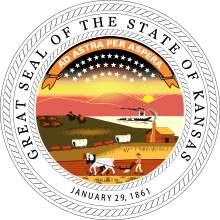Kansas Department of Corrections
|
Great Seal of the State of Kansas | |
 | |
| Agency overview | |
|---|---|
| Headquarters |
714 SW Jackson St, Ste 300 Topeka, Kansas |
| Employees | 3,644 full time employees |
| Agency executive |
|
| Website | www.doc.ks.gov |
The Kansas Department of Corrections[1] is a cabinet-level agency of Kansas that operates the state's correctional facilities, both juvenile and adult; the state's parole system; and the state's Prisoner Review Board. It is headquartered in Topeka.[2]

Correctional Facilities
The Kansas Department of Corrections operates 10 main correctional facility sites, and three satellite correctional facility sites.[3]
- El Dorado Correctional Facility (inmate capacity 1511)
- Ellsworth Correctional Facility (inmate capacity 913)
- Hutchinson Correctional Facility (inmate capacity 1784)
- Kansas Juvenile Correctional Complex (capacity )
- Lansing Correctional Facility (inmate capacity 2351)
- Larned Correctional Mental Health Facility (inmate capacity 438)
- Larned Juvenile Correctional Facility (capacity )
- Norton Correctional Facility (inmate capacity 835)
- Topeka Correctional Facility (inmate capacity 815) - Women in the Kansas state prison are incarcerated here[4]
- Winfield Correctional Facility (inmate capacity 554)
- Wichita Work Release Facility (inmate capacity 250)
Prisoner Review Board
Under the indeterminate release structure, the Prisoner Review Board [5] determines when an incarcerated inmate will be released. Furthermore, the Board establishes supervision conditions of parole and conditional release,[6] discharges successful parole and conditional releasees from supervision per the recommendation of the parole officer and revokes the release of those who have violated the conditions of their supervision.
On July 1, 1993, the legislature enacted the sentencing guidelines system. In this process, the Prisoner Review Board gained the responsibility of establishing conditions of supervision for inmates released on post-release supervision. The board is also responsible for revoking those individuals who have violated their conditions of release. Under both systems, the Prisoner Review Board has the responsibility to review executive clemency applications and make recommendations to the Governor regarding the clemency.[7]
Community & Field Services
The community and field services division[8] has two units - parole[9] and community corrections.[10]
Victim Services
The Office of Victim Services (OVS)[11] provides confidential support and information to victims, survivors, and witnesses if the offender in the crime was sentenced to incarceration in the Kansas Department of Corrections. Services provided include victim notification,[12] safety planning,[13] victim restitution,[14] parole comment session advocacy, Victim/Offender Dialogue (VOD) program,[15] facility tours, and apology letters.[16]
See also
- List of law enforcement agencies in Kansas
- List of United States state correction agencies
- List of U.S. state prisons
- Prison
References
- ↑ Home Page, Kansas Department of Corrections
- ↑ Contacts, KDOC.
- ↑ Correctional Facilities, KDOC
- ↑ "Admission RDU." Kansas Department of Corrections. Retrieved on December 6, 2915.
- ↑ Prisoner Review Board, KDOC
- ↑ Post-Release Conditions, KDOC
- ↑ Clemency, KDOC
- ↑ Community & Field Services, KDOC
- ↑ Parole Services, KDOC
- ↑ Community Corrections, KDOC
- ↑ Victim Services, KDOC
- ↑ Victim Notification, KDOC
- ↑ Safety Planning, KDOC
- ↑ Restitution, KDOC
- ↑ VOD program, KDOC
- ↑ Apology Repository, KDOC

